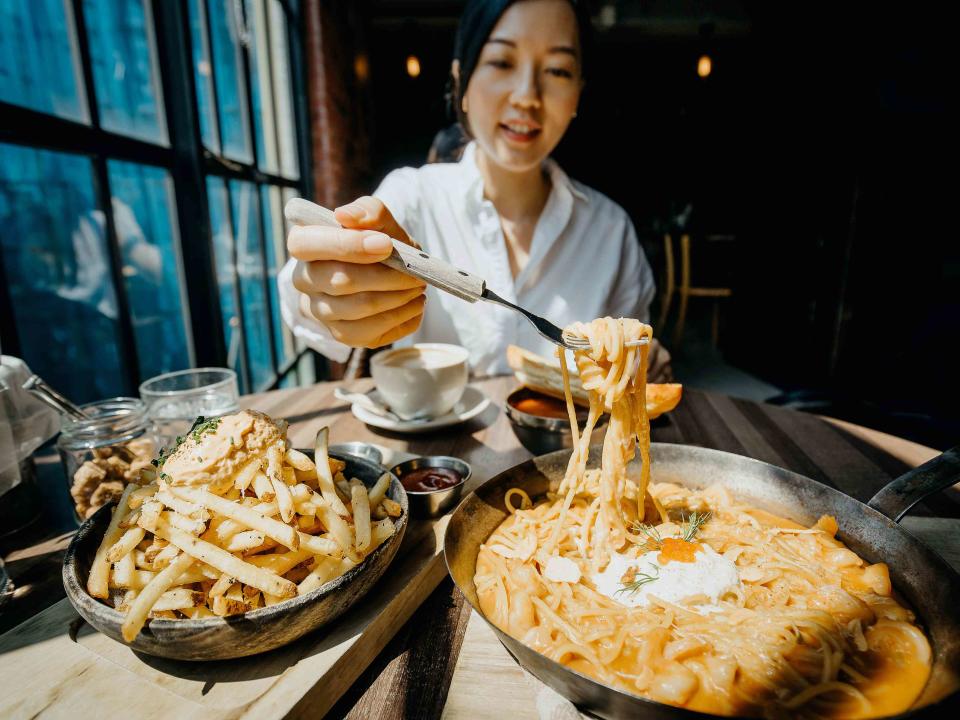6 Things Chefs Never Do When Ordering at a Restaurant
Avoid these mistakes when ordering, if you want a good meal.

d3sign/Getty Images
Going out to eat should be a treat, especially if you're at a restaurant that's known for having high-quality service and food. However, sometimes a restaurant might disappoint you and not live up to its standards, simply because of how or what you ordered that compromised the meal. Resist the urge to assume the worst and consider these common dining mistakes that chefs suggest you avoid to make sure you are getting the highest quality meal possible.
Common Restaurant Ordering Mistakes to Avoid, According to Chefs
1. Ordering Seafood at a Non-seafood Restaurant
You should only order seafood when it's guaranteed to be of high-quality from a reputable source. "Do not order crab or crabcakes from restaurants not located on the coast or that are not known for seafood," says Executive Chef Steve Chiappetti of the Albert, a restaurant located in downtown Chicago. "In a similar vein, don't go anywhere near seafood on a buffet if it is not properly iced," Chiapetti adds. (Think: a salad that's topped with shrimp or a seafood-based soup, like chowder.) It requires cold temperature for both safety and taste, and you don't want to risk getting sick later from eating some bad seafood.
2. Eating Salad That's Been Sitting Out
A bed of greens might be a healthy choice, but not necessarily, if it hasn't been refrigerated for a while. "Be mindful of eating salad at restaurants when the ingredients have been sitting out at room temperature," Chiapetti says. So, if you're dining buffet-style, be wary of salads, and don't be embarrassed to ask the kitchen how long they've been sitting out for.
3. Ordering Over- or Under-cooked Meat
"Steak is one of my favorite proteins, and it's common for my family and I to select a steakhouse when enjoying the rare evening out," Chiapetti says. "I trust the chefs at restaurants I visit so I won't typically tell them how to cook a steak, but keep this in mind—every cut of meat really has a cooking temperature that lets you enjoy the best of the cut," Chiapetti notes. For instance, Chiapetti suggests serving ribeye medium rare, tenderloin rare or medium rare, and short ribs braised. A well-done temperature will make steak too dry and tough, explains Chef Devin Kreller from the restaurant Wood in Chicago. "The kitchen will also serve the worst cut they have for this," Kreller notes. "When I go to a steakhouse, I ask the server to ask the chef to serve the meat at the best temperature based on the cut I'm in the mood for," Chiapetti says. They know what to do.
4. Skipping Gelato or Ice Cream That's Listed on the Menu
If you order a slice of cake and it comes with a scoop of ice cream, don't expect anything fancy. "Gelato and ice cream can sometimes be an afterthought, or something to just have 'on hand,' and if you don't see ice cream as an actual dessert on the menu, it's not likely you're in for the highest quality experience," Chiapetti explains. However, if ice cream or gelato is offered for dessert and listed as a specific item on the menu, it's probably delicious, and could be something really special.
5. Ordering "Specials" at a New Restaurant
Daily specialties, such as "soup of the day" or certain types of seafood or pasta, can be hit or miss. "Ordering specials can be good if it is a restaurant you have tried before and trust in the kitchen and service," Kreller says. "Others may just be trying to sell an item they have too much of," Kreller explains. For instance, the "soup of the day" could consist of whatever's been sitting in the kitchen that's about to expire. Always use your best judgement here.
6. Making Unnecessary Modifications to an Order
Of course, sometimes modifications are necessary; however, you shouldn't request substitutions based on preference or what you're in the mood for. "Only modify a dish if you have an allergy, and it can be easily omitted without compromising the quality of the chef's vision," Kreller suggests. So, don't ask for a different cheese, dressing or type of nut to top a salad, without reason (such as an allergy). It's designed that way intentionally, so trust the chef's craft and thought process behind the ingredients, and you'll enjoy the dish a lot more.

